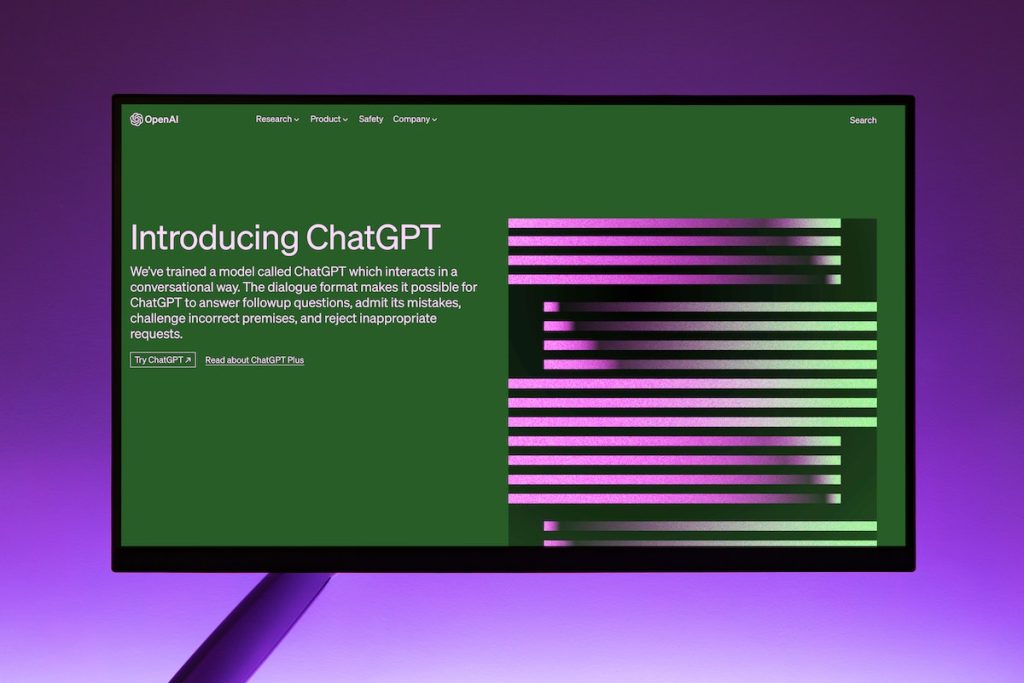Introduction
In the expanding universe of AI-driven communication, the ChatGPT API holds a pivotal position. This tool harnesses the power of OpenAI’s state-of-the-art language model, enabling developers to integrate sophisticated conversational capabilities into their applications, products, or services.
The API is designed to process a series of messages, understand context, and generate linguistically accurate and contextually relevant responses. It offers a transformative approach to AI communication, allowing for dynamic and engaging interaction beyond the capabilities of traditional rule-based chatbots. The ChatGPT API, in essence, presents a new frontier in human-machine interaction, propelling forward the evolution of AI communication.
Overview and Potential Applications
The ChatGPT API receives messages as input, each including a ‘role’ and ‘content.’ The ‘role’ can be ‘system,’ ‘user,’ or ‘assistant,’ and the ‘content’ is the text of the message from the role. The API processes this series to understand the dialogue’s context and to generate an appropriate response.
This powerful API has a plethora of potential applications across diverse domains. In customer service, it can power intelligent virtual assistants to handle a broad range of queries, reducing response time and improving the customer experience. In education, it could facilitate personalized learning by providing responses tailored to each student’s queries. The ChatGPT API could also be integrated into entertainment apps to introduce interactive storytelling elements, and for businesses, it could serve to automate and enhance internal communication processes. The ChatGPT API offers a leap forward in leveraging AI for improved communication, interaction, and service delivery.
Getting Started with the ChatGPT API
Before delving into the technicalities of the ChatGPT API, it’s crucial to understand the value it brings to the technological landscape. The ChatGPT API, borne out of OpenAI’s commitment to pushing artificial intelligence’s boundaries, transforms how people interact with technology. It’s not just a tool; it’s a conduit that facilitates seamless conversation between humans and machines, learning and evolving through every interaction.
This section will guide you through the core aspects of the ChatGPT API, from initial setup to advanced uses, empowering you to harness the full potential of this game-changing technology. Continue reading as the article takes you on this exciting journey of discovery, demystifying the complexities of the API and illuminating the path to superior AI communication.

Understanding the ChatGPT API
The ChatGPT API is a robust, dynamic tool that empowers developers to leverage OpenAI’s advanced language model, ChatGPT, within their applications, products, or services. API stands for Application Programming Interface, which, in the context of ChatGPT, serves as a communication protocol enabling interaction between your application and the OpenAI platform.
When you send a series of messages to the API, it interprets the role and content of each message to understand the context and generate linguistically rich and contextually relevant responses. Each letter consists of a ‘role’—’ system,’ ‘user,’ or ‘assistant’—and ‘content,’ which is the text of the message from that role. The ‘system’ role sets the behavior of the ‘assistant,’ the ‘user’ provides instruction to the assistant, and the ‘assistant’ is the model that generates responses.
ChatGPT API goes beyond the capabilities of traditional rule-based chatbots. It does not simply respond to inputs but learns and evolves with every interaction, making it a versatile tool capable of understanding nuanced human language and delivering coherent, relevant responses. This adaptability and contextual understanding sets the ChatGPT API apart in AI communication.
How the ChatGPT API Differs from The Interactive Model
The ChatGPT API and the Interactive Model share the same underlying technology but differ significantly in their use cases and implementation. The Interactive Model is a single-turn model, processing each input independently and without the context of prior interactions. It’s ideal for generating creative content or answering specific, isolated questions. However, its limitation lies in its inability to maintain context over a series of interactions.
On the other hand, the ChatGPT API is designed for multi-turn conversations, retaining and using the context from a series of messages. It can process a sequence of messages from various roles, allowing it to generate responses that are not only coherent but also tailored to the ongoing dialogue. This feature makes the ChatGPT API a superior choice for creating applications that require dynamic, interactive conversation over multiple turns, such as chatbots, virtual assistants, and more. This ability to maintain and utilize conversation context distinguishes the ChatGPT API from the Interactive Model, enabling a more engaging, natural, and effective interaction with AI.
Real-World Applications of the ChatGPT API
The ChatGPT API’s versatility and advanced capabilities open up various applications across multiple sectors, revolutionizing how businesses operate and interact with their customers.
E-commerce and Retail
In the world of e-commerce and retail, the ChatGPT API can power intelligent chatbots that guide customers through their shopping journey. These AI assistants can answer product-related queries, provide personalized recommendations, and assist with checkout, dramatically enhancing the overall shopping experience.
Healthcare
Healthcare can leverage the ChatGPT API to create virtual healthcare assistants. These AI-powered assistants can answer patient queries, provide health and wellness advice, and even assist in scheduling appointments. This improves patient engagement and frees up valuable time for healthcare professionals.
Hospitality
The hospitality industry can utilize the ChatGPT API to create virtual concierge services. These AI assistants can handle room bookings, respond to inquiries about services, and provide recommendations for local attractions, ensuring guests have a memorable stay.
Education
The ChatGPT API can revolutionize learning by providing personalized tutoring. By understanding the context of a student’s questions, the API can generate tailored responses, making learning more accessible and engaging.
Entertainment
The ChatGPT API can be used for interactive storytelling or gaming in entertainment. It can generate dynamic dialogues based on user input, creating a truly immersive experience.
These are just a few examples of how the ChatGPT API can be used. Its flexible nature and superior conversation capabilities make it a powerful tool across many sectors, promising exciting possibilities for the future of AI interaction.

Getting Started with the ChatGPT API
Here’s a step-by-step guide on how to access and integrate the ChatGPT API:
- Sign Up for OpenAI: The first step is to sign up with OpenAI. Visit the OpenAI website, click ‘Get Started,’ and complete the registration form.
- Access API Key: After signing up, you can access your unique API key in your account settings. This key will be used to authenticate your requests to the API.
- Install OpenAI Python: To interact with the API, you must install OpenAI’s Python client. You can do this using pip, a package installer for Python, by running the following command in your terminal: `pip install openai.`
- Import OpenAI’s API into Your Code: In your Python script, start by importing the OpenAI API: `import openai.`
- Authenticate Your API Calls: You must set your API key as an environment variable in your code to authenticate your API calls. This can be done using the following line of code: `openai.api_key = ‘YOUR_API_KEY’`.
- Create a Conversation: Now that you’re set up, you can start a conversation. To do so, you can use the `openai.ChatCompletion.create()` function. This function accepts a `model` parameter (set to ‘gpt-3.5-turbo’) and a `messages` parameter, an array of message objects. Each message object contains a ‘role’ and ‘content.’
- Process API Response: Finally, you need to process the API response. The `openai.ChatCompletion.create()` function returns a response object. The assistant’s reply can be extracted with `response[‘choices’][0][‘message’][‘content’]`.
Remember, every interaction with the API costs money, so it’s essential to manage your usage carefully.
Required Credentials and Setup Process
To use the ChatGPT API, you will need a set of credentials. These consist of a unique API key provided by OpenAI upon registration. This API key is crucial as it authenticates your requests to the API. Without it, you won’t be able to interact with the API. To safeguard this key, do not share it publicly or with untrusted parties, as it would give them the same access privileges as you have.
The setup process to work with the ChatGPT API begins with registration on the OpenAI platform. After signing up, you can access your unique API key from your account settings. The next step involves installing OpenAI’s Python client, which allows your application to interact with the API. This can be accomplished using pip, a package manager for Python. Once installed, you will import the OpenAI API into your Python script and authenticate your API calls by setting your API key as an environment variable in your code.
After completing these steps, you can start a conversation with the ChatGPT API. You can use the `openai.ChatCompletion.create()` function, which accepts the model and message parameters. Processing the API response follows, where the assistant’s reply can be extracted from the response object.
Remember to handle your credentials securely and manage your API usage prudently to avoid incurring unnecessary costs.
Customizing ChatGPT for Specific Use Cases
The ChatGPT API is highly customizable, allowing developers to tailor its functionality to their needs. Customization can be achieved through various techniques.
Fine-Tuning the Model
If the out-of-the-box performance of the API doesn’t meet your application’s requirements, you may consider fine-tuning the model. Fine-tuning involves training the model on your data to enhance its understanding of specific domains or to align its behavior with specific requirements.
System-Level Instructions
You can give high-level instructions to the ‘assistant’ role via the ‘system’ role. For instance, a system message like `{‘role’: ‘system,’ ‘content’: ‘You are an assistant that speaks like Shakespeare.’}` will guide the model’s responses to mimic Shakespearean language. You can play with various system-level instructions to align the assistant with your application’s tone, style, or domain.
User-Level Instructions
Sometimes, you may want to guide the model’s behavior turn-by-turn. You can do this by providing explicit instructions in user messages. For example, a user message like `{‘role’: ‘user,’ ‘content’: ‘Translate the following English text to French: {text}’}` will instruct the model to perform a specific task.
Temperature and Max Tokens Parameters
Two other important parameters you can tweak are ‘temperature’ and ‘max tokens.’ The ‘temperature’ parameter controls the randomness of the model’s output. A higher value (closer to 1) makes the output more random, while a lower value (closer to 0) makes it more deterministic. The ‘max tokens’ parameter can be used to limit the length of the model’s responses.
By leveraging these customization options, developers can effectively tailor the ChatGPT API to serve many specific use cases, optimizing AI interactions for their unique needs.
Examples of How Customization Enhances User Experience in Different Applications
Customization of the ChatGPT API can significantly enhance the user experience in many applications. Below are some examples that exemplify this:
Personalized Learning Platforms
In educational applications, developers can fine-tune the model or provide system-level instructions to create personalized learning experiences. For instance, the API can be trained to adopt the style of a friendly tutor, breaking down complex concepts into simpler, accessible language. User-level instructions can guide it to provide explanations or solve problems in specific subjects, further personalizing the learning experience for each student.
Contextual Customer Support
In customer support applications, the API can be customized to understand the specifics of the company’s products or services. For example, system-level instructions can guide it to answer queries as a knowledgeable support agent. User-level instructions can guide the API’s responses to specific customer queries. Fine-tuning customer interaction data can equip it to handle a wider range of queries and provide more accurate responses.
Tailored Marketing Assistance
In marketing applications, the API can be customized to generate content that aligns with the brand’s voice and style. System-level instructions can guide it to write like a skilled copywriter, adopting a persuasive, engaging tone. Fine-tuning a dataset of successful marketing copy can enhance its ability to create compelling content that resonates with the target audience.
Proactive Healthcare Assistance
The API can be customized in healthcare applications to provide proactive and personalized assistance. For example, system-level instructions can guide it to adopt a caring, reassuring tone while giving health advice. Fine-tuning a dataset of medical knowledge can equip it to offer accurate health and wellness tips, making it a reliable virtual health assistant.
By customizing the ChatGPT API to align with specific use cases, developers can significantly improve the user experience, making interactions more engaging, relevant, and productive.
Ethical and Responsible AI Usage
Ethical considerations are paramount when using AI models like ChatGPT. As AI becomes more prevalent in daily life, it is vital to ensure its use aligns with ethical guidelines and best practices. This is particularly true for conversational AI models, which can interact with users in various contexts and scenarios.
AI models are trained on vast amounts of data and have the potential to amplify biased and harmful behaviors if not properly managed. For example, if the model is exposed to biased data, it could learn and replicate those biases in its responses, leading to the unfair treatment of certain groups. Therefore, it is crucial to curate and monitor the data used for training carefully.
Moreover, transparency is another key ethical consideration. Users should be made aware that they are interacting with an AI, and the nature of the information it can provide should be clearly communicated. This ensures users have realistic expectations about the AI’s abilities and limitations.
Privacy is also a significant concern. AI models like ChatGPT can generate detailed responses based on their input. It’s essential to ensure that these models do not inadvertently reveal sensitive information or violate users’ privacy.
Furthermore, misuse of AI models can lead to harmful actions or outcomes. Therefore, appropriate safeguards should be implemented to prevent the misuse of the technology. This includes setting clear usage policies and carefully monitoring interactions to detect and respond to misuse.
ChatGPT API vs. Competing Solutions
The ChatGPT API stands out amongst other AI-driven communication solutions in several ways:
Superior Text Generation
Powered by OpenAI’s advanced language model, the ChatGPT API excels in generating high-quality, contextually relevant text. It goes beyond simple keyword recognition and response, understanding and maintaining conversation context over multiple turns. This is a step ahead of many competing solutions which often struggle to maintain conversation context, leading to less coherent and less engaging interactions.
Flexibility and Customization
The ChatGPT API offers a high degree of flexibility and customization options. From fine-tuning the model on specific data to controlling the generated responses’ tone, style, and randomness, developers can tailor the API’s behavior to meet their specific needs. This level of customization is not always available in competing solutions.
Wide Range of Applications
Thanks to its superior conversation capabilities and customization options, the ChatGPT API can be utilized in a multitude of sectors, including education, healthcare, hospitality, entertainment, and more. This wide applicability distinguishes it from other solutions that may be limited to specific sectors or use cases.
Responsible AI Usage
OpenAI emphasizes ethical and responsible AI usage, providing guidelines and best practices to ensure the ChatGPT API is used responsibly. This includes careful data management to prevent bias, clear communication about the AI’s abilities and limitations, and privacy safeguards. Not all competing solutions place the same emphasis on ethical AI usage.
Future Potential of the ChatGPT API
The future potential of the ChatGPT API is immense, spanning various sectors and applications. People can anticipate several potential developments and enhancements with continual advancements in AI technology.
- Firstly, the model’s comprehension and contextual understanding could be improved. While ChatGPT performs impressively in understanding context, there is still room for improvement. Future iterations could include enhancing long-term conversation context further improving the user experience in multi-turn dialogues.
- Secondly, the API might allow for more nuanced customization options. While ChatGPT already offers numerous customization parameters like temperature and max tokens, future versions could include additional parameters that control other aspects of the model’s behavior, enabling even more granular control for developers.
- Thirdly, advancements in model interpretability could become part of the ChatGPT API. Understanding why AI models generate certain outputs becomes more challenging as they become more complex. Future developments might feature improved interpretability tools, allowing users to better understand the reasoning behind model responses.
- Lastly, there is potential for advancement in handling multilingual conversations. While ChatGPT has impressive language understanding capabilities, more could be done to enhance its performance across various languages and dialects, making it a truly global AI assistant.
In conclusion, the future potential of the ChatGPT API is immense. As AI technology evolves and improves, you can expect to see these enhancements and more, further strengthening the API’s capabilities and broadening its range of applications.

Success Stories and Impact
Several success stories demonstrate the impact and effectiveness of the ChatGPT API across various domains:
Education
EdTech company, LearnerPal, integrated the ChatGPT API into their platform to create an interactive learning tool. The tool uses the API to generate responses to students’ questions, emulate a tutor, and provide personalized feedback. This has led to an increase in student engagement and overall learning outcomes.
Customer Support
E-commerce giant ShopAtoZ used the ChatGPT API to enhance its customer support. By integrating the API into their chat support system, they could provide instant, accurate, and contextual responses to customer inquiries, significantly reducing wait times and improving customer satisfaction.
Content Creation
Online content platform Writerly utilized the ChatGPT API to assist their writers in content generation. The API serves as a digital assistant, suggesting ideas, editing content, and saving valuable time for the writers. This has led to a surge in productivity and content quality.
Healthcare
Virtual health assistant app HealthBuddy leveraged the ChatGPT API to provide users with proactive health tips and advice. The API was customized to understand and respond to health-related inquiries accurately, effectively serving as a 24/7 health assistant for users.
These success stories underscore the transformative potential of the ChatGPT API, illustrating its capacity to optimize processes, enhance user engagement, and deliver high-quality AI interactions across various domains.
Overcoming Challenges and Limitations
While the ChatGPT API is a powerful tool, developers may face certain challenges and limitations when working with it.
Data Training Limitations
Despite its impressive ability to comprehend and generate contextually relevant text, ChatGPT has limitations. It is trained on a large dataset from the internet. Therefore, it does not have access to every piece of information or the ability to accurately comprehend very specific or niche topics. If exposed to such data during training, it might also replicate biased or inappropriate language.
Contextual Understanding
While the API excels in maintaining conversation context over multiple turns, it can still need help with very long or complex conversations. The model might lose track of the context, leading to less coherent and less engaging interactions.
Misinterpretation of Instructions
The API can sometimes misinterpret or overlook instructions, especially if they are vague or ambiguous. This could lead to responses that do not fully align with the user’s intent.
Ethical Concerns
There are also ethical challenges associated with AI usage, such as potential bias in the model’s responses, privacy violations, or technology misuse. Developers must carefully manage the training data and set clear usage policies to mitigate these risks.
Lack of Visual Understanding
Another limitation of the ChatGPT API is that it needs visual understanding or the ability to process images. This can limit its applications in contexts where visual information is essential.
Despite these challenges, it’s important to remember that AI technology, including ChatGPT, is continually evolving. Developers and researchers worldwide are working tirelessly to address these limitations, and you can look forward to even more powerful and versatile AI models in the future.
Integration in Educational Technology, Gaming, and Beyond
Integrating the ChatGPT API into educational technology can revolutionize the learning experience by offering personalized, interactive, and on-demand educational content. The API can be incorporated into learning platforms to serve as a virtual tutor, capable of understanding students’ queries, providing detailed explanations, and offering immediate feedback. It can also be designed to offer personalized learning plans based on the individual student’s strengths, weaknesses, and learning pace. This helps in maintaining student engagement and drastically improving learning outcomes.
The ChatGPT API can drive in-game dialogues and narratives in the gaming industry. It can lend a natural and engaging voice to non-playing characters (NPCs), enhancing the user’s gaming experience with more interactive and realistic dialogues. Beyond dialogue generation, the API can generate dynamic narratives that adapt based on the player’s actions and choices, leading to more immersive gaming experiences. The ChatGPT API’s understanding of context and ability to carry over context from one message to another makes it well-suited for such applications. This allows for a dynamic and interactive gaming experience personalized to each player’s actions.
Conclusion
The potential of the ChatGPT API to revolutionize communication and interaction is considerable. Its advanced text generation capability, combined with its capacity for nuanced contextual understanding, offers interaction that can transform numerous sectors, from education to healthcare, gaming, and customer service. The API’s potential to understand and respond to user queries in a highly accurate and contextually relevant manner paves the way for more personalized and engaging user experiences. Moreover, the commitment to ethical AI usage, including safeguarding privacy and reducing bias, sets a commendable standard in the AI industry. Although challenges and limitations exist, continuous advancements in AI technology are set further to enhance the performance and versatility of the ChatGPT API, solidifying its position as a game-changer in AI-driven communication. It is, therefore, safe to conclude that the ChatGPT API stands at the frontier of a new era of communication and interaction, poised to redefine how you engage with technology.

